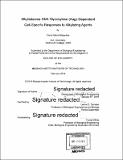Alkyladenine DNA glycosylase (Aag)-dependent cell-specific responses to alkylating agents
Author(s)
Margulies, Carrie Marie
DownloadFull printable version (24.85Mb)
Other Contributors
Massachusetts Institute of Technology. Department of Biological Engineering.
Advisor
Leona D. Samson.
Terms of use
Metadata
Show full item recordAbstract
Methylating agents are ubiquitous in our internal and external environments and can cause damage to all cellular components, including our DNA. If left unrepaired, methylated DNA can cause mutations, cell death, and disease, such as cancer and neurodegeneration. The majority of DNA lesions caused by methylating agents are repaired by the base excision repair (BER) pathway, which is initiated by the lesion-specific alkyladenine glycosylase (Aag). Loss of Aag in embryonic stem (ES) cells renders them sensitive to the methylating agent MMS (methyl methanesulfonate) compared to wild-type (WT). Surprisingly, this phenotype is reversed in hematopoietic myeloid progenitors and cerebellar granule neurons (CGNs) where Aag' cells are resistant to MMS induced killing compared to WT. In this study, we investigated how Aag can cause cell-specific responses to alkylating agents. We generated new WT, Aag-/-, and Aag overexpressing (mAagTg) 129 and C57B1/6 ES cells and showed that inbred genetic background did not affect sensitivity to MMS, indicating this to be a cell-intrinsic response. Moreover, we found that cells overexpressing Aag were even more sensitive to MMS than Aag-/- cells, suggesting that ES cells endure methylation treatment best when they express Aag within an optimal range. To study Aag-dependent neural sensitivity to methylating agents, we optimized protocols for the isolation and culture of primary cerebellar granule neurons and determination of cell death after drug treatment by high-throughput imaging. CGNs isolated from WT, Aag-/-, and mAagTg mice exhibited cell sensitivity to MMS treatment that was dependent on Aag and Parp activity, thus recapitulating in vivo results and proving that CGN death is cell-intrinsic. Cell death was independent of caspases, mitochondrial depolarization, and AIF translocation. We did observe the formation of enlarged mitochondria and are investigating whether mitochondrial dynamics are causative of cell death in an Aag-dependent manner. Finally, we used in vitro hematopoietic and neuronal differentiation to monitor cell responses to MMS as a function of cellular development. Three different methods all successfully generated mature neurons based on morphology, immunochemical staining, and Aag expression. Though we successfully differentiated ES cells into cell types of interest, we are continuing to optimize methods for the assessment of alkylation sensitivity in the resulting heterogeneous populations.
Description
Thesis: Ph. D., Massachusetts Institute of Technology, Department of Biological Engineering, 2016. Cataloged from PDF version of thesis. Includes bibliographical references.
Date issued
2016Department
Massachusetts Institute of Technology. Department of Biological EngineeringPublisher
Massachusetts Institute of Technology
Keywords
Biological Engineering.